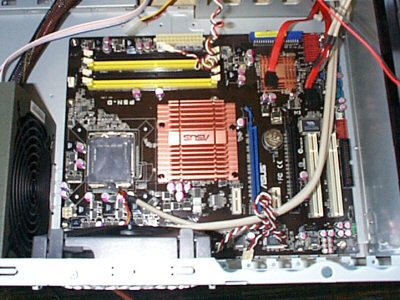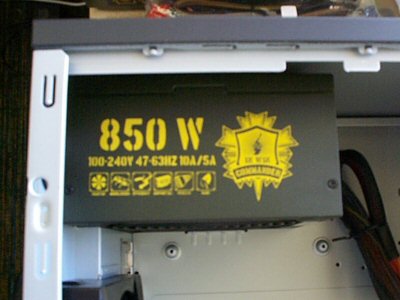A customer of ours recently approached us about building a really nice gaming computer. Yes, I’m a gamer, and I enjoy building computers. I’m still running a 2.33 GHz Core 2 Duo and a GeForce 8800GTS on my personal computer, and it’s starting to show its age, so how could I pass up this opportunity to build a (hopefully not literally) smoking machine? To drool at Crysis running at “Very High” without breaking a sweat? To think about taking this baby for myself?
The customer had in mind what he wanted from a similar machine he found elsewhere, so we had a bit of a guideline. Possibly the most important factor was the video card, so that’s the first thing we settled on. The BFG Technologies GeForce GTX 280 OC2 (factory overclocked to 650 MHz, with 1 GB of onboard memory) was an obvious choice. What else was obvious? Putting in two of those suckers.

Next up, the processor. On our reference sheet, we were looking at an Intel Core 2 Quad overclocked to 3.2 GHz. We didn’t want to fuss with overclocking and potentially destabilizing a customer’s computer, so we selected the Q9650 (3.0 GHz from the factory, with 1333 MHz frontside bus and 12 MB shared L2 cache).
Eight gigs of RAM was also expected. We decided on four two-gigabyte sticks of Kingston HyperX DDR2 at 800 MHz.
But as important as all that is, you’re obviously not going anywhere without a good motherboard. On our reference sheet, we had an MSI P7N SLI-FI. However, this model does not have PCI Express 2.0 slots, and we were not sure about MSI reliability or quality, so that was out. It seemed the Asus P5N-D was the right choice, but as we began assembling the computer, we soon discovered that the second video card blocked the motherboard’s SATA ports.

With a little more research, we came back with an EVGA nForce 750i SLI FTW. An added benefit to this was an extra PCI slot between the PCI Express slots, giving the video cards a little extra breathing room, though this would soon be taken by the sound card. The EVGA board’s SATA ports are at a right angle to the motherboard, giving the video card clearance even when it sits directly over the ports. I still had to swap for the SATA cables included with the Asus motherboard though, since the EVGA SATA cable connectors were too long to fit in our chassis due to the hard drive bay sitting too close.
The customer requested an add-on sound card, and we selected the Asus Xonar D2 PCI sound card. Unfortunately, I couldn’t tell you why, as I didn’t pick it and… let’s just say audio technology is not my field. Unfortunately, I didn’t even take a picture of the thing, but it’s a monster. The color coded LEDs inside the audio jacks are a nice touch.
Speaking of chassis, the chassis was perhaps the most difficult piece to choose. Obviously it needed to be flashy, with good ventilation and cooling, but most importantly it needed to fit those mammoth 10.5″ long video cards. We almost decided on the Antec Nine Hundred, but with many power supplies now having bottom-mounted internal fans and the fact that the Nine Hundred placed the power supply at the bottom of the case, this just didn’t seem like a wise choice.
Then, when we saw the In Win Extreme Series B2 Bomber, we knew.

Its fighter jet/bomber styling (including electric front hatch) and the B2 bomber shaped side vent almost seemed tacky to my conservative sensibilities (I consider case windows “over the top”, so you can see where I’m coming from), but ultimately it was just too cool to pass up. Though the front panel may look a little closed in, there still seems to be plenty of ventilation.
Of course, we also needed a power supply that could push all this. For two GTX280 cards, we wanted at least 850 watts, and with the quality of In Win’s 350 watt units we’ve been using in the shop, we selected In Win’s SLI-certified Commander 850W.

The modular cables are a nice touch, though I only omitted one or two thanks to the graphics cards alone requiring four cables. I was pretty impressed with this unit, which could pretty much be used for anything. Aside from the cables being detachable from the power supply, the connectors are also modular, such as the 2×2 processor power connector having another clip-on 2×2 connector in case you need a 2×4 connector. Also, as with many power supplies now, the motherboard power is easily changeable between 2×20 and 2×22, and even the PCI-E power cables can be used for 2×3 or 2×4 by simply clipping on or removing the extra pins.
With all this excitement, it’s easy to forget a hard drive. The original request was a 1 TB drive, but considering the current reliability issues 1 TB drives seem to be having, we backed it off to a 750 GB SATA Western Digital Caviar Black, and to top it all off, an LG Blu-Ray/DVD/CD burner plus HD-DVD reader with LightScribe. With the cost of one of these things, you almost wonder why you’d buy a dedicated Blu-Ray player.
Alright! So we’ve got our parts. Tune in next time and we’ll build this monster!
The first time that i tried overcloking over a year ago, my CPU got overheated and got fried.`:`